Drones revolutionize precision crop monitoring by giving you a bird's-eye view of your fields. You'll get real-time, high-resolution data on crop health, soil moisture, and pest infestations. This allows for targeted treatments, reducing costs and resource waste. You can quickly assess crop damage after weather events and optimize irrigation strategies. Drones help you detect issues early, often before visible symptoms appear, maximizing yield potential. They're time-saving, environmentally friendly, and provide data for informed decision-making. With automated field analysis technology, you'll have extensive insights at your fingertips. The long-term impact on farming practices is just the beginning of what drones can offer.
Cost-Effective Farm Management
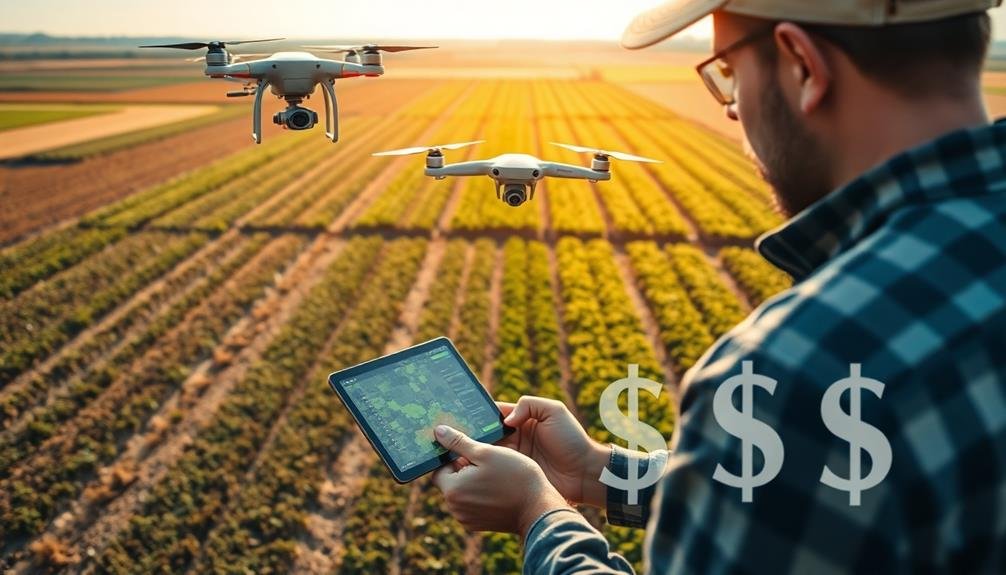
Precision agriculture drones are revolutionizing cost-effective farm management. They provide you with a bird's-eye view of your fields, allowing you to spot issues that might go unnoticed from the ground. You'll save time and resources by precisely targeting problem areas instead of treating entire fields unnecessarily.
These drones can capture high-resolution images and collect data on crop health, soil moisture, and pest infestations. You'll be able to make informed decisions about irrigation, fertilization, and pest control, optimizing your inputs and reducing waste. This targeted approach not only cuts costs but also minimizes environmental impact.
With drone technology, you can monitor crop growth throughout the season, identifying areas of stress or underperformance early on. This early detection enables you to address issues promptly, potentially saving crops and increasing yields.
You'll also be able to assess crop damage after extreme weather events quickly, facilitating faster insurance claims and recovery planning.
Real-Time Crop Health Assessment
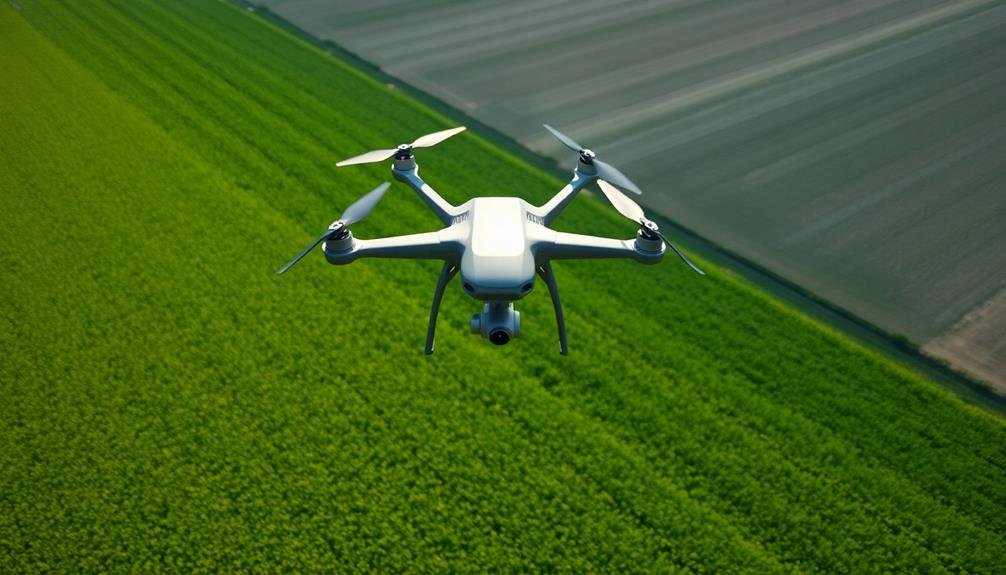
Building on the cost-saving benefits of drone technology, real-time crop health assessment takes farm management to the next level. With drones, you can quickly identify problems in your fields that might otherwise go unnoticed until it's too late. These aerial scouts capture high-resolution images and collect data on plant health, moisture levels, and pest infestations.
You'll receive immediate insights into your crops' condition, allowing you to make informed decisions promptly. Drones equipped with multispectral cameras can detect stress in plants before visible symptoms appear, giving you a vital head start in addressing issues. By analyzing vegetation indices like NDVI, you'll pinpoint areas that need attention, optimizing your resource allocation.
Real-time assessments enable you to adjust irrigation, apply targeted treatments, and fine-tune your management practices on the fly. This precision approach not only improves crop yields but also reduces environmental impact by minimizing unnecessary chemical applications.
You'll be able to monitor crop progress throughout the growing season, ensuring timely interventions and maximizing your harvest potential. With drone-assisted real-time crop health assessment, you're empowered to make data-driven decisions that boost your farm's productivity and sustainability.
Efficient Water Resource Management

You'll find drones invaluable for efficient water resource management in agriculture.
By employing targeted irrigation strategies, you can precisely deliver water where it's needed most, reducing waste and optimizing crop growth.
You'll also benefit from drones' ability to detect soil moisture levels, allowing you to make informed decisions about when and where to irrigate your fields.
Targeted Irrigation Strategies
Drone-assisted targeted irrigation strategies frequently revolutionize water resource management in agriculture. You'll find that these advanced techniques allow you to apply water precisely where and when it's needed, greatly reducing waste and improving crop yields.
By using drones equipped with multispectral cameras and thermal sensors, you can identify areas of your field that require more or less water. This data helps you create detailed irrigation maps, enabling you to adjust your watering patterns accordingly.
You'll be able to detect early signs of water stress in plants, allowing for timely intervention before crop damage occurs.
With drone-assisted targeted irrigation, you can implement variable rate irrigation systems. These systems adjust water flow based on the specific needs of different sections of your field.
You'll save water by avoiding over-irrigation in areas that don't need it, while ensuring that drought-prone spots receive adequate moisture.
Moreover, you can use drones to monitor the effectiveness of your irrigation systems in real-time. This allows you to quickly identify and address issues like leaks or blockages, further enhancing your water usage and maintaining ideal growing conditions for your crops.
Detecting Soil Moisture Levels
Through the use of drones, detecting soil moisture levels has become a game-changer for efficient water resource management. You'll find that drones equipped with specialized sensors can quickly survey large areas, providing real-time data on soil moisture content. This information allows you to make informed decisions about when and where to irrigate, preventing both over-watering and under-watering.
You can use thermal imaging cameras on drones to detect variations in soil temperature, which often correlate with moisture levels. Multispectral sensors can also identify areas of water stress in crops before visible signs appear. By integrating this data with other factors like weather forecasts and crop growth stages, you'll optimize your irrigation schedule.
Drone-based soil moisture detection isn't just about saving water; it's about improving crop health and yield. You'll reduce the risk of root diseases caused by excessive moisture and minimize crop stress from drought conditions.
This precision approach helps you maintain ideal growing conditions across your fields, leading to more uniform crop development and potentially higher yields. Ultimately, you're not just conserving water; you're maximizing its effectiveness in your farming operations.
Precise Pest and Disease Detection
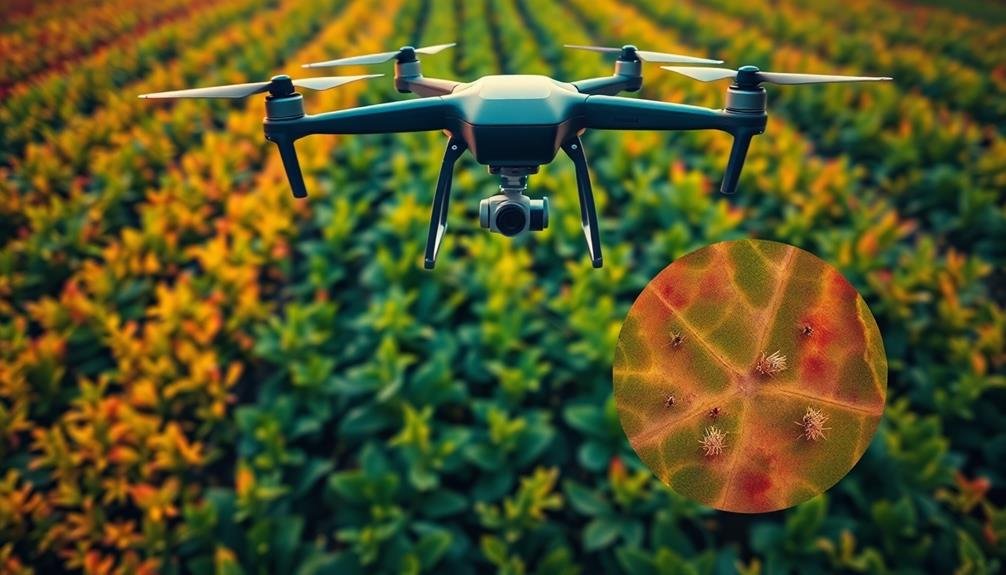
You'll find drones invaluable for spotting pest infestations and disease outbreaks early in your crops.
Early Outbreak Identification
One of the most powerful applications of drone technology in agriculture is early outbreak identification. You'll be able to spot potential issues before they become widespread, saving time, money, and crops. Drones equipped with high-resolution cameras and multispectral sensors can detect subtle changes in plant health that might be invisible to the naked eye.
By regularly flying over your fields, you're creating a thorough map of crop health. This allows you to:
- Identify pest infestations in their early stages
- Detect fungal diseases before they spread
- Spot nutrient deficiencies as they emerge
- Locate areas of water stress or drainage issues
- Recognize weed growth patterns
With this information, you can take targeted action quickly. Instead of treating entire fields, you'll be able to focus on specific problem areas. This precision approach not only reduces the use of pesticides and fertilizers but also minimizes environmental impact.
Early outbreak identification through drone technology gives you a significant advantage in managing your crops. You'll be able to make informed decisions faster, potentially preventing major crop losses and ensuring higher yields.
It's a proactive approach that can revolutionize your farming practices.
Targeted Treatment Applications
Building on early outbreak identification, targeted treatment applications take precision agriculture to the next level.
With drones, you'll be able to pinpoint exact locations of pest infestations or disease outbreaks in your fields. This precision allows you to apply treatments only where they're needed, reducing chemical usage and costs.
You'll use high-resolution imagery and multispectral sensors to detect subtle changes in plant health. These tools help you identify specific pests or diseases affecting your crops.
Armed with this information, you can create precise treatment maps for your fields. Your ground crews or automated spraying systems can then use these maps to apply pesticides, fungicides, or other treatments with pinpoint accuracy.
You'll minimize overspray and reduce the impact on beneficial insects and surrounding ecosystems. This targeted approach not only saves money but also promotes more sustainable farming practices.
Optimized Fertilizer Application
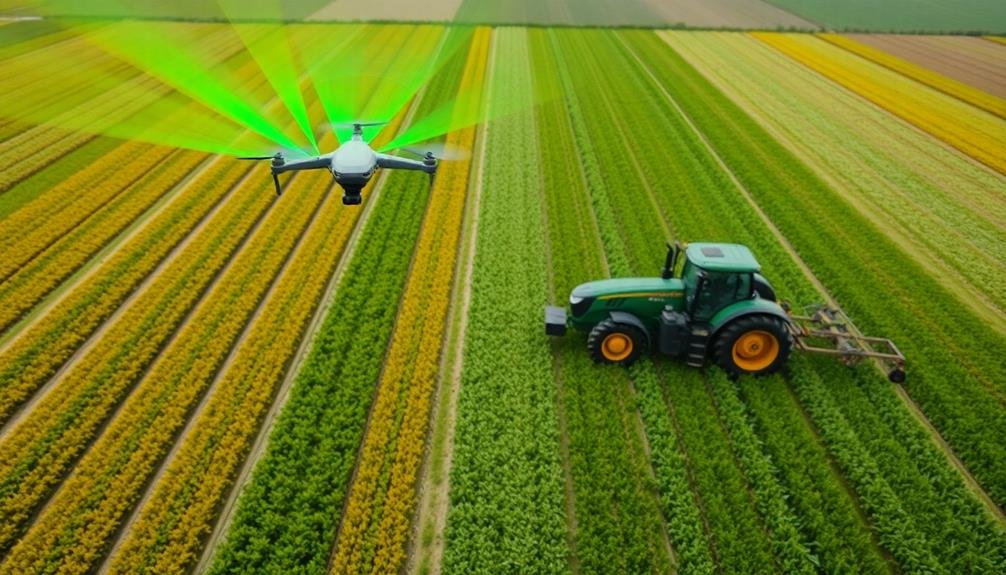
Precision agriculture has revolutionized fertilizer application, and drones are at the forefront of this transformation. You'll find that drone technology allows for precise nutrient management, reducing waste and improving crop yields.
By using drones equipped with multispectral cameras and sensors, you can create detailed maps of your fields, identifying areas that need more or less fertilizer. These maps enable you to apply fertilizer exactly where it's needed, in the right amounts.
You'll save money on inputs while minimizing environmental impact. Drones can even be used to apply fertilizer directly, especially in hard-to-reach areas or for spot treatments.
Here are key benefits of using drones for optimized fertilizer application:
- Increased efficiency in nutrient management
- Reduced fertilizer waste and environmental impact
- Improved crop health and yield
- Cost savings on inputs
- Enhanced ability to address nutrient deficiencies quickly
Crop Yield Prediction

You'll find that drones excel at data-driven yield forecasting, allowing you to make informed decisions about your crops' potential output.
By analyzing drone-captured imagery, you're able to detect problems early, such as pest infestations or nutrient deficiencies, which could impact your harvest.
This advanced insight enables you to optimize resource allocation, ensuring you're investing time and materials where they're needed most to maximize your crop yield.
Data-Driven Yield Forecasting
As we explore data-driven yield forecasting, it's clear that drones have revolutionized crop yield prediction. These aerial devices collect vast amounts of data, enabling farmers to make accurate predictions about their harvest.
By combining drone imagery with advanced algorithms and machine learning, you can forecast yields with unprecedented precision.
Data-driven yield forecasting offers numerous benefits:
- Improved resource allocation
- Early detection of potential issues
- Better financial planning
- Optimized harvest timing
- Enhanced market positioning
You'll find that drone-based yield forecasting provides a thorough view of your fields. It allows you to analyze plant health, growth patterns, and stress indicators across large areas quickly.
This information, when combined with historical data and weather forecasts, creates a powerful predictive model.
Early Problem Detection
Early problem detection is a game-changer in crop yield prediction. With drones, you'll spot issues before they become widespread, allowing for swift intervention. These aerial scouts can identify pest infestations, disease outbreaks, and nutrient deficiencies in their early stages.
By capturing high-resolution images and using specialized sensors, drones provide you with detailed information about your crops' health. You'll be able to detect subtle changes in plant color, texture, and growth patterns that might be invisible from the ground.
This early warning system enables you to take targeted action, applying treatments only where needed. You'll save time, resources, and potentially your entire harvest. Drones can also help you identify irrigation issues, drainage problems, and soil compaction areas.
By addressing these concerns promptly, you'll minimize crop stress and optimize growth conditions. Moreover, drone-assisted early problem detection allows you to make data-driven decisions about crop management.
You'll have a clear picture of your field's overall health, helping you prioritize interventions and allocate resources efficiently. This proactive approach notably improves your chances of maximizing yield and crop quality.
Optimizing Resource Allocation
Optimizing resource allocation is a critical aspect of crop yield prediction that drones excel at. By capturing high-resolution imagery and data, drones provide you with valuable insights to make informed decisions about resource distribution. You'll be able to allocate water, fertilizers, and pesticides more efficiently, reducing waste and maximizing crop potential.
Drones equipped with multispectral cameras can detect variations in plant health, soil moisture, and nutrient levels across your fields. This information allows you to create precise prescription maps for targeted applications, ensuring that each area receives exactly what it needs. You'll save money on inputs while minimizing environmental impact and improving overall crop quality.
- Identify areas of stress or underperformance
- Create variable-rate application plans
- Monitor irrigation efficiency
- Assess fertilizer uptake and effectiveness
- Track crop growth stages for ideal harvesting
Time-Saving Aerial Surveys

Efficiency is the name of the game when it comes to aerial surveys with drones. You'll save countless hours by using these flying machines to quickly scan large areas of your crops. Instead of walking through fields or driving tractors, you can deploy a drone to cover the same ground in a fraction of the time.
Drones equipped with high-resolution cameras and specialized sensors can capture detailed images and data about your crops' health, growth patterns, and potential issues. You'll receive this information in real-time, allowing for rapid decision-making and problem-solving. This quick turnaround means you can address concerns before they escalate, potentially saving your crop yield.
Here's a breakdown of time-saving benefits:
| Task | Traditional Method | Drone Method | Time Saved |
|---|---|---|---|
| Field Mapping | 1-2 days | 1-2 hours | 80-90% |
| Crop Health Assessment | 3-4 days | 2-3 hours | 75-85% |
| Pest Detection | 2-3 days | 1-2 hours | 70-80% |
| Irrigation Monitoring | 1-2 days | 30-60 minutes | 85-95% |
Environmental Impact Reduction
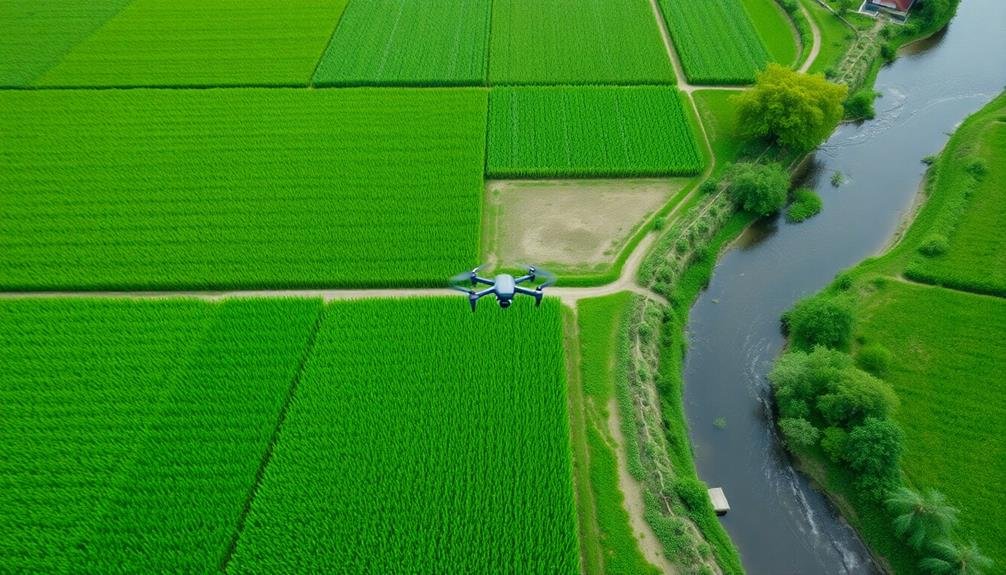
Drones frequently contribute to reducing the environmental impact of traditional farming practices. By utilizing these aerial devices, you'll minimize soil compaction caused by heavy machinery and decrease the need for excessive chemical applications.
Drones enable you to precisely target problem areas, reducing overall pesticide and herbicide use while maintaining crop health.
You'll also conserve water resources by employing drones for irrigation management. They can detect moisture levels and identify areas requiring targeted watering, preventing overwatering and runoff.
Additionally, drones help you optimize fertilizer application, reducing nutrient leaching and protecting nearby water sources from contamination.
Here's how drones contribute to environmental impact reduction in farming:
- Decrease soil compaction by reducing heavy machinery use
- Minimize chemical applications through targeted treatments
- Conserve water with precision irrigation management
- Reduce fertilizer runoff by optimizing application
- Lower carbon emissions by replacing fuel-intensive farm equipment
Data-Driven Decision Making
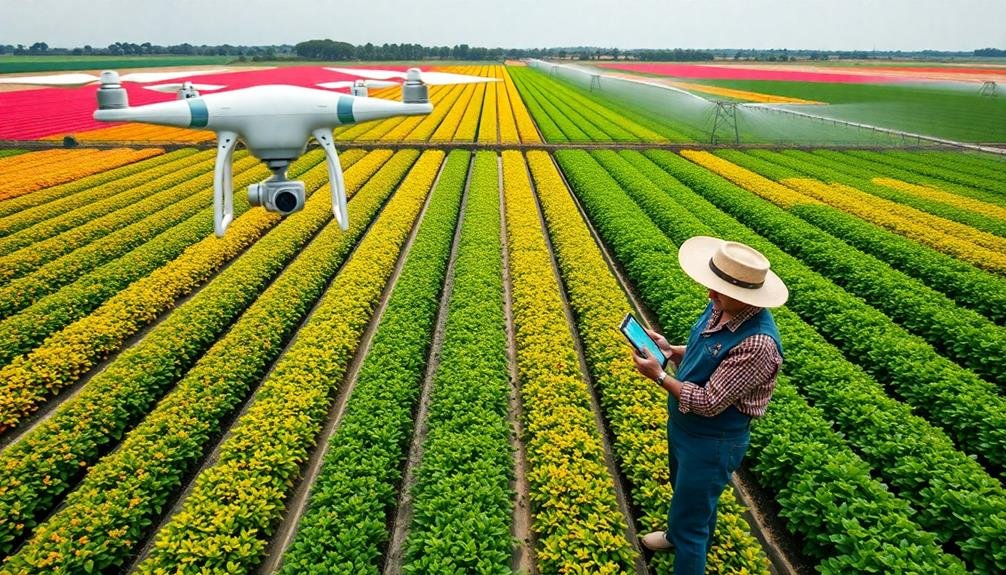
Farmers armed with drone-collected data can make more informed decisions about their crops. You'll find that drones provide a wealth of information, allowing you to analyze your fields with unprecedented precision.
By using multispectral and thermal imaging, you can identify areas of stress, pest infestations, or nutrient deficiencies before they're visible to the naked eye.
With this data, you're able to create detailed maps of your fields, highlighting variations in crop health, soil moisture, and even plant height. You can then use this information to tailor your irrigation, fertilization, and pest control strategies to specific areas of your farm. This targeted approach not only improves crop yields but also reduces waste and minimizes environmental impact.
Moreover, you'll be able to track crop development over time, comparing current conditions to historical data. This allows you to make proactive decisions, adjusting your management practices based on trends and patterns.
Automated Field Analysis

Automated field analysis takes data-driven decision making to the next level. With drones equipped with advanced sensors and AI-powered software, you'll gain unprecedented insights into your crops' health and performance. These aerial systems can quickly scan vast areas, collecting data on plant vigor, stress levels, and nutrient deficiencies.
You'll benefit from:
- Real-time crop health maps
- Early detection of pests and diseases
- Precise irrigation management
- Optimized fertilizer application
- Yield prediction and harvest planning
By leveraging automated field analysis, you're no longer relying on manual scouting or sporadic satellite imagery. Instead, you'll have access to frequent, high-resolution data that allows for timely interventions and informed decision-making. This technology enables you to address issues before they become widespread, potentially saving entire crops from devastation.
Moreover, automated field analysis helps you fine-tune your farming practices. You'll be able to identify areas of your field that consistently underperform, allowing you to adjust your management strategies accordingly.
This level of precision not only increases yields but also reduces waste and environmental impact, making your operation more sustainable and profitable in the long run.
Frequently Asked Questions
What Training Is Required to Operate Drones for Agricultural Purposes?
You'll need to complete a drone pilot certification course, learn agricultural mapping software, and understand crop monitoring techniques. It's also essential to familiarize yourself with local regulations and practice flying in various weather conditions.
How Do Weather Conditions Affect Drone Performance in Crop Monitoring?
Weather greatly impacts your drone's performance. Wind can disrupt flight, while rain affects sensors and camera quality. You'll face reduced battery life in extreme temperatures. Sunlight glare may interfere with image capture during midday flights.
Are There Any Legal Restrictions on Using Drones for Farm Management?
Yes, there are legal restrictions on using drones for farm management. You'll need to comply with FAA regulations, including registering your drone, obtaining proper licenses, and following rules about where and when you can fly.
Can Drones Be Integrated With Existing Farm Management Software Systems?
Yes, you can integrate drones with existing farm management software. They'll seamlessly connect with your current systems, allowing you to upload and analyze drone-collected data alongside other farm metrics for thorough decision-making and improved efficiency.
What Are the Limitations of Drone Technology in Precision Agriculture?
You'll find that drone tech in precision agriculture has limitations. They're affected by weather, have short flight times, and require skilled operators. Data interpretation can be complex, and there are regulatory restrictions to take into account.
In Summary
You've seen how drones revolutionize precision crop monitoring. They'll save you money, time, and resources while boosting your farm's efficiency. With real-time data at your fingertips, you're empowered to make informed decisions quickly. You'll optimize water use, detect issues early, and apply inputs precisely. By embracing drone technology, you're not just improving your yields – you're also reducing your environmental impact and setting yourself up for long-term success in modern agriculture.

As educators and advocates for responsible drone use, we’re committed to sharing our knowledge and expertise with aspiring aerial photographers.
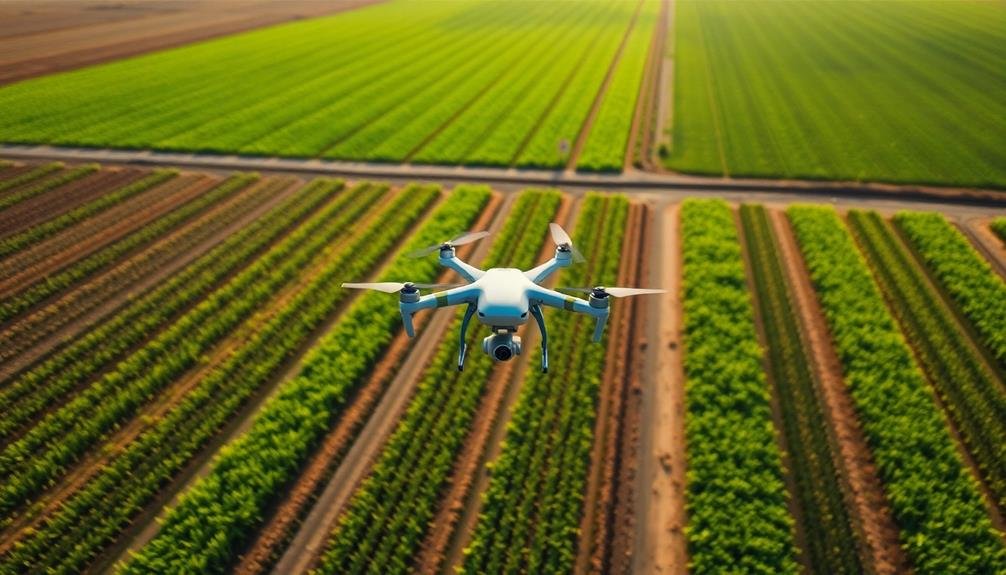



Leave a Reply